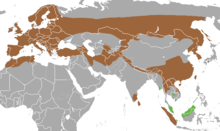

| Lutra | |
|---|---|

| |
| Eurasian otter (Lutra lutra) | |
| Scientific classification | |
| Domain: | Eukaryota |
| Kingdom: | Animalia |
| Phylum: | Chordata |
| Class: | Mammalia |
| Order: | Carnivora |
| Family: | Mustelidae |
| Subfamily: | Lutrinae |
| Genus: | Lutra Brisson, 1762 |
| Type species | |
| Mustela lutra Linnaeus, 1758 | |
| Species | |

| |
| Range of Lutra lutra (brown), Lutra sumatrana (green) | |
Lutra is a genusofotters, one of seven in the subfamily Lutrinae.
The genus includes these species:
| Common name | Scientific name and subspecies | Range | Size and ecology | IUCN status and estimated population |
|---|---|---|---|---|
| Eurasian otter | Lutra lutra (Linnaeus, 1758) |
coasts of Europe, many parts of Asia, and parts of northern Africa
|
Size: Habitat: Diet: |
NT
|
| Hairy-nosed otter | Lutra sumatrana (Gray, 1865) |
Southeast Asia
|
Size: Habitat: Diet: |
EN
|
| Image | Scientific name | Common name | Distribution |
|---|---|---|---|
 |
L. nippon | Japanese otter | Japan |
The genus most likely evolved in Asia during the late Pliocene epoch;[1] the oldest fossil belonging to the genus is of the species L. palaeindica, and dates from the late Pliocene.[2]
Lutra species are semiaquatic mammals, so they are well-adapted to both water and land. They prefer shallow, narrow areas of streams surrounded by mature trees and with rocks, especially where weirs reduce the flow of the water, as well as attract fishes. They seem to tolerate roads and residential and agricultural areas, but only moderate human interaction. They clearly avoid areas without vegetation cover and rocks.[3]
The otters' diets consist mainly of fish (hence, the aquatic environment). However, during the winter and in colder environments, fish consumption is significantly lower and the otters use other resources for their food supply. Their diets can consist of amphibians (mainly frogs and pond turtles), bird predation (mainly anserine species), small rodents, and invertebrates such as water beetles, snails, and crayfish. They have also feed on plants, specifically grasses. With this large diversity of prey and resources for their diets, otters are considered "opportunistic eaters".[4]
Some otters live in solitude, while others live in groups.
|
| |||||||||||||||||||||||||||||||||
|---|---|---|---|---|---|---|---|---|---|---|---|---|---|---|---|---|---|---|---|---|---|---|---|---|---|---|---|---|---|---|---|---|---|
| |||||||||||||||||||||||||||||||||
| |||||||||||||||||||||||||||||||||
| |||||||||||||||||||||||||||||||||
| Lutra |
|
|---|---|
| Authority control databases: National |
|
|---|
This article about a carnivoran is a stub. You can help Wikipedia by expanding it. |